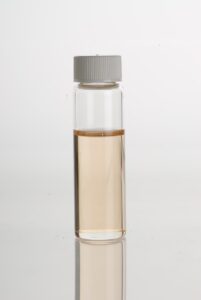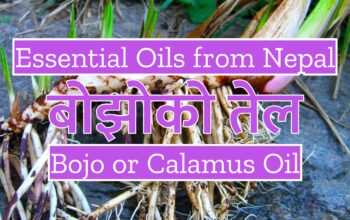Wintergreen Oil
Botanical name:Gaultheria fragrantissima Wall.
Family:Ericaceae
Description of the plant:
Wintergreen plant is an evergreen botany found in the Central and Eastern regions of Nepal at 1,200 to 2,600 m in the Mahabharata Mountain range. The height of the plant is about 1 m. to 3 m. The leaves are leathery, rough and have fine teeth on the edges. The small green and white flowers on the top bloom in the month of Falgun-Jestha i.e., February-June and they are slightly fragrant. In Nepal, it is also called Limunijhar (limunijhāra), Machino (machhino) and Patpate (paṭapaṭē).
Processing Method:
Wintergreen Oil can be produced from the leaves of Wintergreen plant by Steam Distillation for about 5 to 6 hours. The amount of oil in the leaves depends on many factors. The timing of crop collection, leaf condition, distillation technique, mixing of other substances etc. affect the quantity and quality of Wintergreen Oil produced. The amount of oil can be increased by soaking the collected leaves in warm water for 4 to 5 hours.
Properties of Wintergreen Oil:
Wintergreen Oil is light red or pink in color. It has a strong & sweet smell, which is like methyl salicylate. Among the chemical compounds found in Wintergreen oil, methyl salicylate is a major compound and makes up 92 to 99 percent of the oil. The properties of Wintergreen oil found in Nepal are like those of essential oils extracted from the leaves of Gaultheria procumbens found in the United States.
Uses:
Wintergreen oil is used as an aromatic oil in the manufacture of the following items. The amount to be used is given in parentheses. In perfumes like Fern and Cyperus, in alcoholic beverages (56ppm), in toothpaste, in ice cream (44ppm), in candy (peppermint, chocolate) (260ppm), in biscuits or other similar substances (1500ppm), in chewing gum (3900m), and in medicine (e.g., Methyl salicylate liniment, Methyl salicylate ointment). Acetyl salicylic acid (also known as Aspirin) can be made from the Wintergreen oil.
धसिँग्रेको तेल
वानस्पतिक नामः गल्थेरिया फ्राग्रेन्टिसिमा
वानस्पतिक परिवारः एरिकेसी
बिरुवाको वर्णन:
धसिँग्रेको बोट नेपालको मध्यमाञ्चल तथा पर्वूाञ्चल क्षेत्रमा पर्ने महाभारत पवर्तशृङ्खलाको १,२०० देखि २,६०० मि. सम्मको उचाइका पाखामा सधैँ हरियो रहने दरिलो बुट्यानका रूपमा पाइन्छ। बिरुवाको उचाइ करिब १ मि. देखि ३ मि. सम्मको हुन्छ। यसको पात चाम्रा, खस्रो र किनारामा मसिना दाँतीहरु भएका हुन्छन्। टुप्पामा हरियो रङ्गीन सेता साना फूल फागुन– जेठ महिनामा फुल्दछन् र ती हल्का सुवासित हुन्छन्। नेपालमा यसलाई लिमुनीझार, मछिनो र पटपटे पनि भनिन्छ।
प्रशोधन विधिः
धसिँग्रेको पातबाट करिब ५ देखि ६ घन्टासम्म स्टीम डिस्टिलेसन (steam distillation) प्रक्रियाद्वारा सुगन्धित तेल उत्पादन गर्न सकिन्छ। पातमा रहेको तेलको परिमाण अनेकौ कारणहरूमा निभर्र गदर्छ। बाली सङ्कलनको समय, पातको अवस्था, डिस्टिलेसन प्रविधि, अन्य पदार्थको मिसावट आदि कुराहरूले तेलको परिमाण र गुणमा असर पार्दछ। सङ्कलित पातलाई ४ देखि ५ घन्टासम्म मनतातो पानीमा डुबाएर प्रशोधन गरेमा तेलको मात्रा बढाउन सकिन्छ।
धसिँग्रेको तेलका गुणहरु:
तेल हलकुा रातो वा प्याजी रङ्गको हुन्छ। तेलको गन्ध कडा, मीठो र मिथाइल स्यालिसिलेट (methyl salicylate)को जस्तै सुगन्धित हुन्छ। तेलमा पाइने रासायनिक तइभ्वहरूमध्ये मिथाइल स्यालिसिलेट मुख्य हो, जसको भाग ९२ देखि ९९ प्रतिशतसम्म रहेको पाइन्छ। नेपालमा पाइने धसिँग्रेको तेलका गुणहरू अमेरिकामा पाइने गल्थेरिया प्रोक्युम्बेन्स (Gaultheria procumbens) को पातबाट निकालिएको सुगन्धित तेलसँग मिल्दाजुल्दा छन्।
उपयोगिताः
धसिँग्रेको तेल निम्न वस्तुहरू बनाउने कार्यमा सुगन्धित तेलका रूपमा प्रयागे गरिन्छ। प्रयागे गरिने मात्रा कोष्ठभित्र दिइएको छ। फर्न (fern) र सिपेरस (cyperus) किसिमका अत्तरहरूमा, अमादक पेय पदार्थमा (56ppm), दन्तमञ्जन, आइसक्रिममा (44ppm), क्यान्डी (पिपरमेन्ट, चकलेट) मा (260ppm), बिस्कुट वा त्यस्तै अन्य पदार्थहरूमा (1500ppm), चुइङ्गममा (3900ppm) र औषधिमा (उदाहरणः Methyl salicylate liniment, Methyl salicylate ointment)। धसिँग्रेको तेलबाट एसिटाइल स्यालिसिलिक एसिड (acetyl salicylic acid) (जसलाई एस्पिरिन (aspirin) पनि भनिन्छ) बनाउन सकिन्छ।





